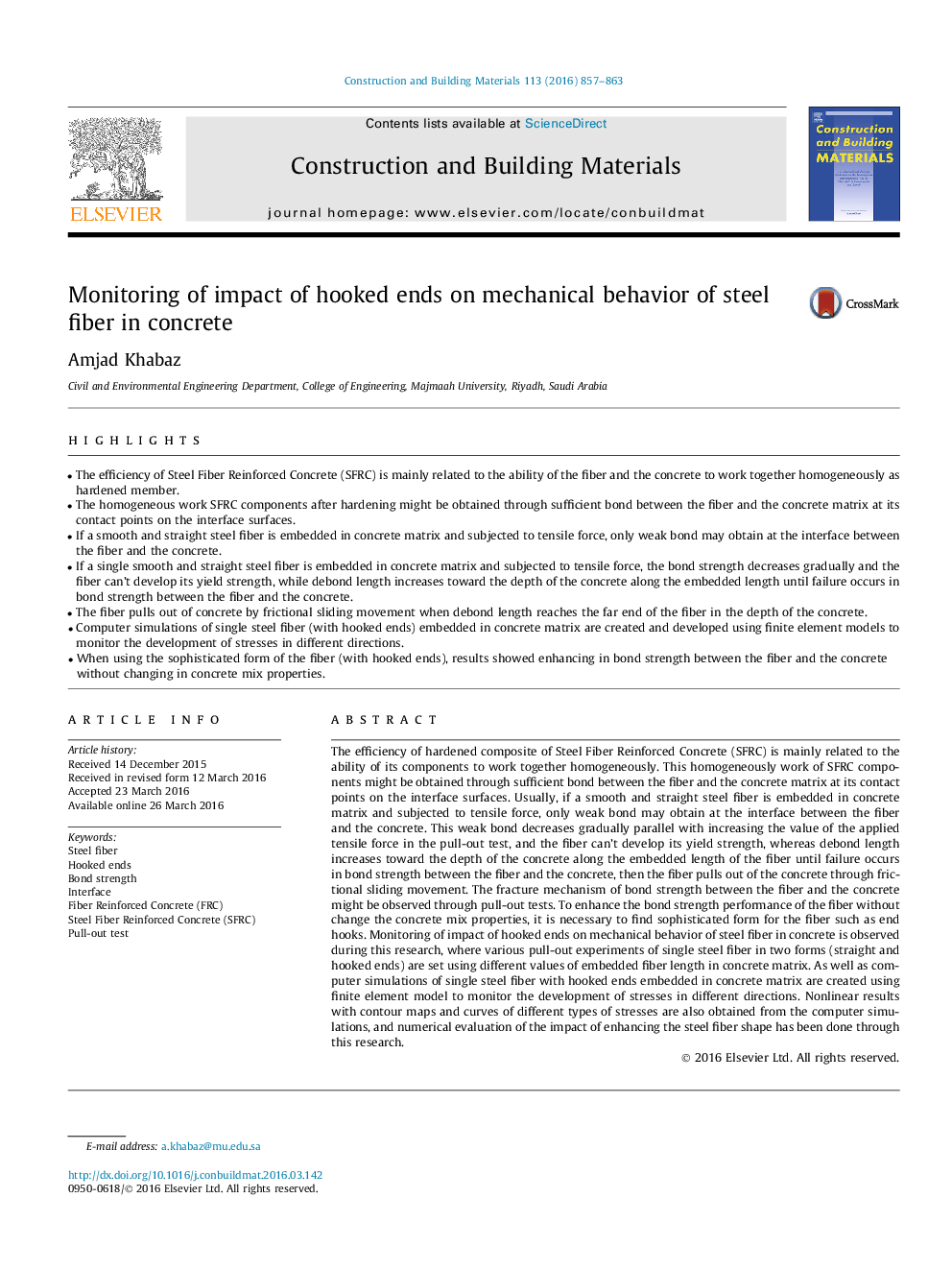| کد مقاله | کد نشریه | سال انتشار | مقاله انگلیسی | نسخه تمام متن |
|---|---|---|---|---|
| 256215 | 503543 | 2016 | 7 صفحه PDF | دانلود رایگان |
• The efficiency of Steel Fiber Reinforced Concrete (SFRC) is mainly related to the ability of the fiber and the concrete to work together homogeneously as hardened member.
• The homogeneous work SFRC components after hardening might be obtained through sufficient bond between the fiber and the concrete matrix at its contact points on the interface surfaces.
• If a smooth and straight steel fiber is embedded in concrete matrix and subjected to tensile force, only weak bond may obtain at the interface between the fiber and the concrete.
• If a single smooth and straight steel fiber is embedded in concrete matrix and subjected to tensile force, the bond strength decreases gradually and the fiber can’t develop its yield strength, while debond length increases toward the depth of the concrete along the embedded length until failure occurs in bond strength between the fiber and the concrete.
• The fiber pulls out of concrete by frictional sliding movement when debond length reaches the far end of the fiber in the depth of the concrete.
• Computer simulations of single steel fiber (with hooked ends) embedded in concrete matrix are created and developed using finite element models to monitor the development of stresses in different directions.
• When using the sophisticated form of the fiber (with hooked ends), results showed enhancing in bond strength between the fiber and the concrete without changing in concrete mix properties.
The efficiency of hardened composite of Steel Fiber Reinforced Concrete (SFRC) is mainly related to the ability of its components to work together homogeneously. This homogeneously work of SFRC components might be obtained through sufficient bond between the fiber and the concrete matrix at its contact points on the interface surfaces. Usually, if a smooth and straight steel fiber is embedded in concrete matrix and subjected to tensile force, only weak bond may obtain at the interface between the fiber and the concrete. This weak bond decreases gradually parallel with increasing the value of the applied tensile force in the pull-out test, and the fiber can’t develop its yield strength, whereas debond length increases toward the depth of the concrete along the embedded length of the fiber until failure occurs in bond strength between the fiber and the concrete, then the fiber pulls out of the concrete through frictional sliding movement. The fracture mechanism of bond strength between the fiber and the concrete might be observed through pull-out tests. To enhance the bond strength performance of the fiber without change the concrete mix properties, it is necessary to find sophisticated form for the fiber such as end hooks. Monitoring of impact of hooked ends on mechanical behavior of steel fiber in concrete is observed during this research, where various pull-out experiments of single steel fiber in two forms (straight and hooked ends) are set using different values of embedded fiber length in concrete matrix. As well as computer simulations of single steel fiber with hooked ends embedded in concrete matrix are created using finite element model to monitor the development of stresses in different directions. Nonlinear results with contour maps and curves of different types of stresses are also obtained from the computer simulations, and numerical evaluation of the impact of enhancing the steel fiber shape has been done through this research.
Journal: Construction and Building Materials - Volume 113, 15 June 2016, Pages 857–863
